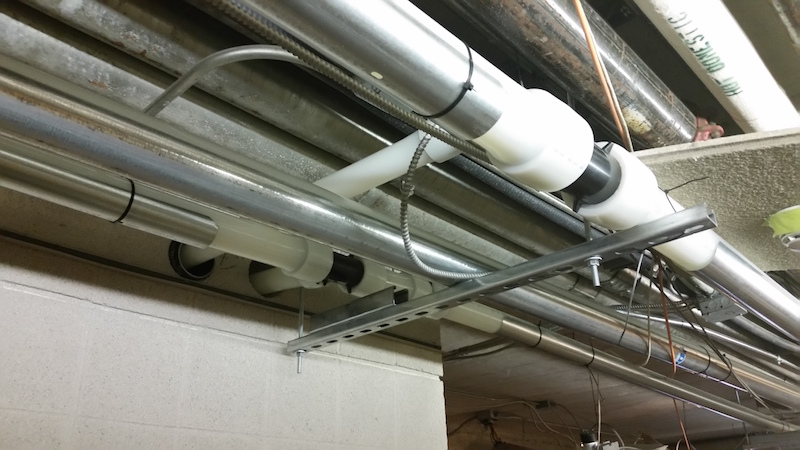Increases in energy costs are leading many building owners and facility managers to look for more cost-effective ways to heat and cool their buildings. Apartment buildings and student residences currently using electric systems are prime candidates for conversion to hydronic heating systems, and sometimes even water-based cooling systems.
Wilfred Laurier University, in Waterloo, Ont., opted to retrofit the electric heating systems in two of its existing student residences. The school went with hydronic heating and cooling for one of the buildings and hydronic heating for the other (which continues to use its existing forced-air DX cooling system).
The Bricker Residence, a nine-story apartment-style structure with four-bedroom suites that feature a common kitchen, bathroom and living room, required a retrofit that was designed to have fan coil units located in each of the suites, and a new piping system added to supply heating and cooling water in a two-pipe switch-over system.
The five-story Grand River Residence included classrooms and administrative offices on the first two floors with residence rooms on floors three through five. The project was designed to have hydronic reheat coils added to the existing VAV boxes already installed in the offices, classrooms and suites while the existing forced-air cooling system was kept intact. Due to the configuration of the building and the various locations of the VAV boxes, each floor had its own main loop that was fed with larger-diameter risers.

Tight timeframes and tight spaces
One of the key challenges was to have the installations completed when students were on summer break. Due to the tight timeline, and the fact that these were both existing finished buildings, mechanical contractor Modern Niagara opted to use PEX piping instead of a rigid pipe system. There were a number of areas where space was limited for the installation of pipe, so the flexible nature of Uponor PEX proved to be advantageous in those areas.
Uponor Design Services created the piping designs for each of the projects to ensure the pipe sizing and flow rates would meet with the engineer’s original design calculations and requirements. The project incorporated PEX sizes up to and including 3" diameter pipe with larger sizes being black iron.
For the Bricker Residence, Uponor PEX risers were installed between floors to connect to each of the fan coil units. The Grand River Residence utilized smaller-diameter Uponor PEX branched from the main loop on each floor to feed each of the reheat coils.
For both projects, the installers transitioned between black iron pipe and 3" PEX with brass threaded transitions and/or flange kits. Flange kits were also used for connecting the PEX pipe to some valves and circuit setters. Most of the horizontal PEX installations included Uponor PEX-a Pipe Support to allow for fewer hanging brackets and to help minimize pipe expansion.
Upon completion, the systems were filled and pressure tested, and the piping system was insulated before reinstalling the ceiling panels and sections of drywall. Thanks to the ingenuity of the system design and the efficiency of the installation crews, both projects were completed on schedule and the buildings were ready for the fall semester of incoming students.
Related Stories
| May 22, 2014
Facebook, Telus push the limits of energy efficiency with new data centers
Building Teams are employing a range of creative solutions—from evaporative cooling to novel hot/cold-aisle configurations to heat recovery schemes—in an effort to slash energy and water demand.
| May 22, 2014
7 ways it pays to use BIM for data centers
Here’s where AEC firms and owners are getting the most bang for the buck when using BIM/VDC to coordinate data center projects.
| Dec 10, 2013
16 great solutions for architects, engineers, and contractors
From a crowd-funded smart shovel to a why-didn’t-someone-do-this-sooner scheme for managing traffic in public restrooms, these ideas are noteworthy for creative problem-solving. Here are some of the most intriguing innovations the BD+C community has brought to our attention this year.
| Sep 9, 2013
Top 25 continuing education courses on BDCuniversity
An overview of the 25 most popular continuing education courses on BDCuniversity.com.
| Jun 18, 2013
Report: HVAC occupancy sensors could slash building energy demand by 18%
Researchers at the DOE's Pacific Northwest National Laboratory conclude that significant energy savings can be achieved by varying ventilation levels based on the number of people in a given space.
| Apr 1, 2013
Half of building owners use 'smart' technologies, says survey
A survey of 291 building owners by IDC Energy Insights shows that 50% of owners use smart building technologies, such as HVAC controls, lighting controls, and analytics/data management.
| Mar 27, 2013
Small but mighty: Berkeley public library’s net-zero gem
The Building Team for Berkeley, Calif.’s new 9,500-sf West Branch library aims to achieve net-zero—and possibly net-positive—energy performance with the help of clever passive design techniques.
| Feb 3, 2013
Electronic surveying improves accuracy on BIM-driven hospital project
A mechanical contractor combines an electronic surveying tool with a BIM model to make significant productivity gains in a large-scale hospital project.















